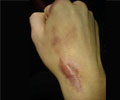Low-intensity vibration can help wounds heal more quickly, report researchers at the University of Illinois at Chicago.

Timothy Koh, UIC professor of kinesiology and nutrition in the UIC College of Applied Health Sciences, was intrigued by studies at Stony Brook University in New York that used very low-intensity signals to accelerate bone regeneration.
"This technique is already in clinical trials to see if vibration can improve bone health and prevent osteoporosis," Koh said.
Koh and his coworkers at UIC collaborated with Stefan Judex of Stony Brook to investigate whether the same technique might improve wound healing in diabetes. The new study, using an experimental mouse model of diabetes, is published online in the journal PLOS One.
The low-amplitude vibrations are barely perceptible to touch.
"It's more like a buzz than an earthquake," said Eileen Weinheimer-Haus, UIC postdoctoral fellow in kinesiology and nutrition, the first author of the study.
Advertisement
Wounds exposed to vibration formed more granulation tissue, a type of tissue important early in the wound-healing process. Vibration helped tissue to form new blood vessels -- a process called angiogenesis -- and also led to increased expression of pro-healing growth factors and signaling molecules called chemokines, Weinheimer-Haus said.
Advertisement
"The exciting thing about this intervention is how easily it could be translated to people," Koh said. "It's a procedure that's non-invasive, doesn't require any drugs, and is already being tested in human trials to see if it's protective of bone loss." A clinical study, in collaboration with Dr. William Ennis, director of the Wound Healing Clinic at UIC, is planned, Koh said.
Source-Eurekalert









